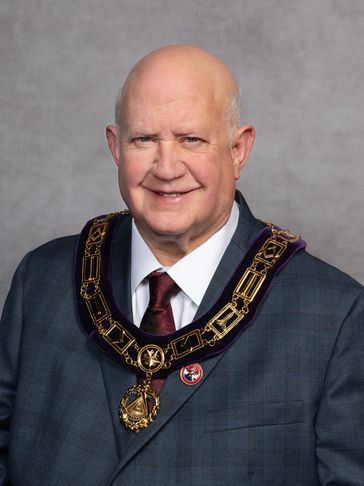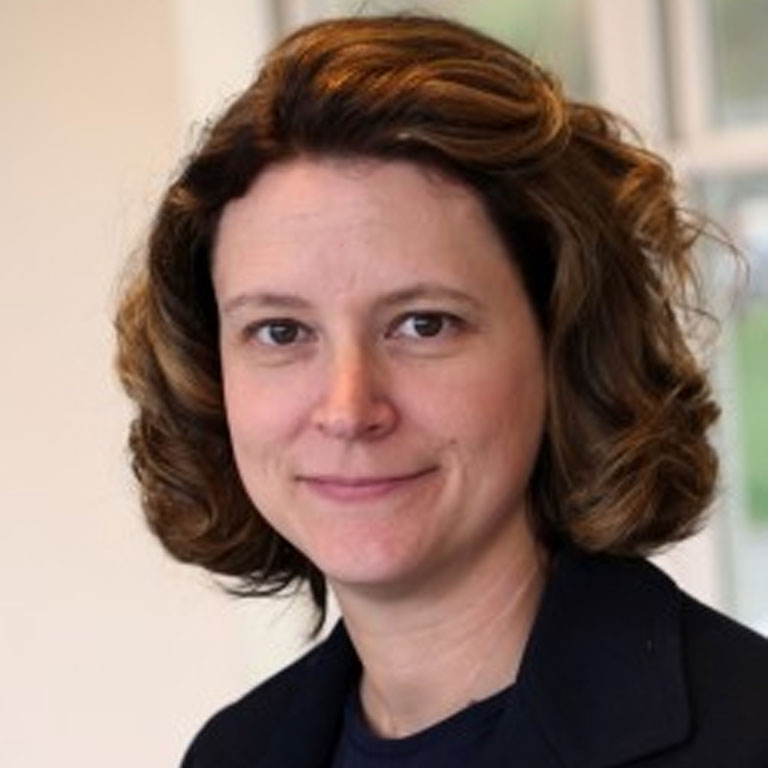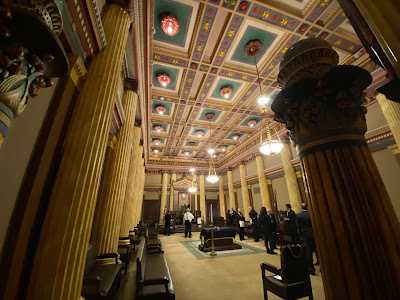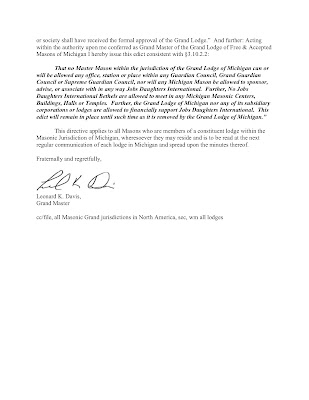Wednesday, March 29, 2023
Thanks To New York's Adelphic-Union Lodge 14 (PHA)
Tuesday, March 28, 2023
Speaking Tonight at New York's Adelphic-Union Lodge 14 (PHA)
Michigan Grand Master Issues Follow Up Letter on Job's Daughters Situation
"While it is true my edict says no Job's Daughters International Bethels could meet in a Masonic building, that does not mean I am banning YOU. the Michigan youth and adults, from using our Masonic facilities to gather as a social club, as friends, or as a “Kids Lodge". With adult chaperones, youth may gather for fellowship, to study, to play games, share meals together, or any other activities not related to Job's Daughters International.
"For those who continue your journey with Job's Daughters International, I wish you great success, growth, and happiness in all you do. I will do my best to support you in any way possible that is not in conflict with the edict."
(Click image to enlarge)
Monday, March 27, 2023
Grand Master Shuts Down Job's Daughters in Michigan
That no Master Mason within the jurisdiction of the Grand Lodge of Michigan can or will be allowed any office, station or place within any Guardian Council, Grand Guardian Council or Supreme Guardian Council, nor will any Michigan Mason be allowed to sponsor, advise, or associate with in any way Jobs Daughters International. Further, No Jobs Daughters International Bethels are allowed to meet in any Michigan Masonic Centers, Buildings, Halls or Temples. Further [sic], the Grand Lodge of Michigan nor any of its subsidiary corporations or lodges are allowed to financially support Jobs Daughters International. This edict will remain in place until such time as it is removed by the Grand Lodge of Michigan.”
(Click images to enlarge, or view online at https://michiganmasons.org/news-events/)
The landing page of the Michigan Job's Daughters Grand Bethel has been scrubbed of information and directs all questions to their secretary.
There is a youth protection program run by the Job's Board of Trustees (who are also elected), and any adult involved with children must complete a background check and be a Certified Adult Volunteer (CAV). If there is an incident reported, there is supposed to be an investigation, and an appeals process is in place.
In Michigan recently there was an incident that resulted in one adult’s CAV designation being revoked; in this incident it was claimed an adult physically struck a child, there was a CAV violation report filed by an uninvolved party. But according to multiple sources, there are several witnesses who claim that the alleged event did not happen as reported (the adult is 21 and the Daughter was her own younger cousin). There was no investigation, neither the adult nor the youth were interviewed — the woman’s CAV was summarily revoked. (There have been rumblings that the complaint was filed in retribution for things that happened in the past — hard to verify in the light of flying email accounts and commentary.)
According to one insider, the Youth Protection program is specifically in place to protect members from harm, not to discipline adults for things unrelated to youth safety. Objections were immediately raised regarding not following the official process of Job’s Daughters — reportedly, the four adult leaders who questioned the process subsequently had their own CAV status revoked, including three elected state officers.
When Michigan Grand Master Davis got wind of all this rumpus, he requested a meeting with the state and national Job’s leadership. They reportedly agreed to meet, but never showed up. For whatever reason, they simply chose not to respond after that, and, according to sources, even dodged him at the Conference of Grand Masters in Alexandria, Virginia last month.
Two male members of the international Supreme Guardian Council were Michigan Masons, and the Grand Master apparently declared that if the Supreme Guardian Council wouldn’t meet with him, they would be suspended. He apparently asked for a review of the decisions and an assurance that they were made in accordance with their own internal policy.
For Michigan’s Job’s Daughters' charter to be returned, the Supreme Guardian demanded the Grand Master of Masons in Michigan revoke his "edict" in writing. Additionally, all appeals filed in accordance with the youth protection plan must be withdrawn, as should any filed lawsuits.
Obviously, his questions and demands were not met over the last week, hence his very real edict issued today.
Saturday, March 25, 2023
Grand Master Renders Official Decision on Transgenders and Masonry in Texas
.png/:/rs=h:192,cg:true,m/qt=q:95)
 |
| Grand Master G. Clay Smith |
His complete ruling can be seen below, but to paraphrase the meat of his answer:
- A biological woman ("an individual who was assigned female at birth") cannot be a Texas Mason.
- A transgender man ("an individual who was assigned female at birth whose gender identity or gender expression is now male") cannot be a Texas Mason.
- A transgender woman ("an individual who was assigned male at birth whose gender identity or gender expression is now female") cannot be a Texas Mason.

"[T]he Old Charges must be understood in the context in which they were written and at the time they were incorporated into our Constitution adopted in 1920, not given new meaning based on current attitudes and practices among some concerning gender and or other matters. Anyone who desires to become a Mason, and any Mason who wishes to remain in our fraternity, must be a man, as Dr. Anderson understood men to be in 1722, and as our Texas forbearers understood them to be at the time of adoption of our current Constitution."
"It is important to understand that this decision does not constitute a judgement of this Grand Lodge, moral or otherwise, on the issues of gender identity, gender expression, or transgender issues. As in the case of spiritual and political matters, every Mason is free to form a private opinion on the subject. The Grand Lodge of Texas is forever committed to individual freedom of conscience and personal liberty in every lawful pursuit. However, not every such pursuit qualifies an individual to become a Mason."
The entire Decision can be seen below. Click image to enlarge.
Many suppose that dealing with transgenderism is a relatively new topic to be confronted by the fraternity, but it's not. Several decades ago, a midwestern grand lodge went through a lawsuit brought by an existing member who underwent gender reassignment surgery to become a woman, and then fought ferociously to remain a Mason in "her" lodge. The suit failed, as the judge fell back on a common practice in lawsuits involving voluntary membership associations: because the Grand Lodge's rules and by-laws stipulated that all members must be men, and that members agree in their initiation to abide by the rules of the fraternity, the plaintiff had no grounds to sue. But that was more than 30 years ago, and society has changed dramatically.
3. APPLICATIONS FOR ADMISSIONA candidate for admission to Freemasonry under UGLE must be a man. Should a person who has undergone gender reassignment and has become a man apply to become a Freemason then his application must be processed in the same way as for any other male candidate.
Any qualified candidate for admission may be proposed for membership of a private lodge in accordance with the provisions in the Rules contained in the Book of Constitutions. No candidate should be subjected to questions about their gender which could make them feel uncomfortable.
4. CONTINUED MEMBERSHIP
A Freemason who after initiation ceases to be a man does not cease to be a Freemason. We expect that Freemasons will act with compassion and sensitivity towards their fellow Freemasons.
We hope that no Freemason would engage in unwanted conduct relating to another Freemason’s actual or perceived gender reassignment or gender transition. Such conduct would not only be unmasonic but is also unlawful if it has the purpose or effect of violating the dignity of, or creating an intimidating, hostile, degrading, humiliating or offensive environment for, the victim.
5. RESIGNATION FROM THE CRAFTA Freemason who becomes a woman is not required to resign from the Craft.If a person resigns from the Craft then they and their dependants might no longer be eligible for some of the benefits provided by the Masonic charities now or in the future.
6. EXCLUSION FROM A LODGEA Lodge may vote to exclude any member for sufficient cause. The following grounds would constitute unlawful discrimination and so could never constitute sufficient cause:
a. The fact that a member has legally become a woman;b. A mistaken belief that a member has legally become a woman;c. The fact that a member is in the process of transition from male to female; ord. A mistaken belief that a member is in the process of transitioning from male to female.
The situation in England is more complex because English discrimination laws are different from the U.S. Back in 2018, the Brexit vote hadn't taken place yet, and the U.K. was subject to European Union rulings by their Court of Human Rights, as well. Freemasonry is protected under English laws, along with European Union laws from legal accusations of gender discrimination because of the fraternity's long-established, male-only admissions criteria. UGLE is officially recognized in England and Wales under the law as a single-sex association.Similarly, a Lodge must not attempt to persuade a member to resign from the Lodge or discriminate against a member based on any of these grounds. A Lodge must not at any time require a member to prove that they are legally a man.
The problem arose, however, when existing UGLE Masons chose to undergo gender reassignment, which is when English law kicked in. The UGLE's male-only status does not protect them from accusations of discrimination against their existing members. According to a Huffington Post article published at the time, under the Gender Recognition Act 2004 and the Equality Act 2010 a biological man who has joined the Freemasons cannot be excluded after transitioning because gender reassignment is a protected right under the law.
Thursday, March 23, 2023
2023 Sankey Lecture: Heather Calloway Sunday 3/26


The Marie Kondo Method. Swedish Death Cleaning. “Hoarders” reality TV shows. Downsizing.
De-cluttering is a hot trend in our heavily material culture.
At risk, however, is the loss of culturally significant objects and entire collections of ephemera, records, and artifacts.
Dr. Heather K. Calloway, the current Executive Director of University Collections at Indiana University, is working to manage and preserve collections of fraternal organizations, namely, the Freemasons, that are at serious risk of being discarded.
“Whether a lodge is moving, closing, or downsizing their space, the collections amassed by fraternal groups are at risk of being orphaned… They are often stored in closets, basements, and attics where environmental and storage conditions are abysmal. There is little or no emergency planning for these objects,” says Dr. Calloway.
Dr. Calloway will be presenting her lecture, “Skeletons in the Lodge Hall: Hidden Collections and Fraternal Curiosities,” at the 14th Annual Charles A. Sankey Lecture Series on Sunday, March 26th, in Sean O’Sullivan Theatre.
[snip]
“We are always excited when the Sankey Lecture comes around,” says archivist David Sharron, the Head of Archives and Special Collections at the Brock Library. “Hearing presenters like Heather Calloway and the attending Masons and scholars speak about Freemasonry so intelligently and passionately makes us feel secure that the Masonic book collection we have at Brock will always be needed and regarded in the best light.
As a part of the event, which is back in person for the first time since 2019, Dr. Calloway will be bringing some objects from the Indiana University’s collection of Freemason objects. Along with Mr. Sharron, she invites members of the public to bring in their own Freemason objects to discuss their historical significance.
Dr. Calloway notes that, “Fraternal history and material culture is found everywhere. It is held by private groups, archives, public and academic libraries, historical societies, and museums… Without action to address these needs for collection stewardship, many are at high risk for damage or loss.”
When: Sunday, March 26, 2023, 3:00 pm.Where: Sean O’Sullivan Theatre
Please reserve your FREE TICKETS in advance at Eventbrite.
RECEPTION: After the Lecture there will be a reception (from approx. 5:30 to 6:30 pm). All attendees are welcome to stay to chat with the speaker and with members of the Brock and Masonic communities. Light refreshments will be offered free of charge, and a cash bar will be available.
FREEMASON "ANTIQUES ROADSHOW": At the reception attendees are welcome (if they wish) to bring easily portable Masonic or related possessions that might have a historical or personal meaning. While they will not attempt to suggest a monetary value, Prof. Heather Calloway and David Sharron (Brock's University Archivist) will be on hand to discuss the possible significance of your items and strategies for preserving them in the best way possible.
LIVESTREAM OPTION: For those who cannot attend in person, there will also be a livestream during the Lecture. To view the livestream, use your browser to go to http://live.sankeylectures.ca. Participation in the Freemason "Antiques Roadshow" will not be possible via the livestream.
More details can be found on ExperienceBU.
Heather Calloway is currently serving as the Executive Director of University Collections at Indiana University. She spent 14 years at the headquarters of the Scottish Rite Southern Jurisdiction's House of the Temple in Washington, D.C., as the Museum Curator and Managing Director of Digital and Social Media. She's also served as the inaugural archivist for the Archives & Special Collections at Washington College, the University Archivist for the Perdue Museum and Archives at Salisbury University, and as the Librarian/Archivist for the Franciscan Monastery in Washington, D.C.
Saturday, March 18, 2023
Anniversary of the Death of Jacque DeMolay
 Today, March 18th marks the 709th anniversary of the death of Jacques de Molay, the last Grand Master of the Poor Fellow Soldiers of Christ, the Knights Templar. (Some accounts say March 11th. Even the two commemorative plaques at the execution site in Paris have conflicting dates.)
Today, March 18th marks the 709th anniversary of the death of Jacques de Molay, the last Grand Master of the Poor Fellow Soldiers of Christ, the Knights Templar. (Some accounts say March 11th. Even the two commemorative plaques at the execution site in Paris have conflicting dates.)He was born in the eastern French village of Molay in 1244 or 45. Almost nothing is known of his early life, but he joined the Templars at the age of 21, and served 42 years as a warrior monk.
 In 1291, the Holy Land fell back into the hands of the infidel, and would never fully return to Christian rule. The Templars and the Knights Hospitallers fell back to the coastal city of Acre, which was quickly lost. Both orders subsequently went to the island of Cyprus. The Templars remained here, while the Hospitallers later took the island of Rhodes. That too would be lost eventually, and the Hospitallers finally settled in Malta, where they became known as the Knights of Malta. In spite of the modern Masonic orders that unite these two orders of knights, they were bitter rivals for the wealth and favor of Europe and the Church.
In 1291, the Holy Land fell back into the hands of the infidel, and would never fully return to Christian rule. The Templars and the Knights Hospitallers fell back to the coastal city of Acre, which was quickly lost. Both orders subsequently went to the island of Cyprus. The Templars remained here, while the Hospitallers later took the island of Rhodes. That too would be lost eventually, and the Hospitallers finally settled in Malta, where they became known as the Knights of Malta. In spite of the modern Masonic orders that unite these two orders of knights, they were bitter rivals for the wealth and favor of Europe and the Church.Jacques de Molay was elected Grand Master in 1293 at the age of 47. Immediately he set off to England, France, Aragon and Italy to drum up support for a new crusade to the Holy Land, as well as to fend off a growing call for merging the two orders of warrior monks. Politiucally, the Templars were regarded as the men who lost the Holy Land, and monarchies were becoming distrustful of them. France in particular was feeling overrun with returning, aging knights, who still were free from any kind of taxation or even civil laws, by virtue of Papal bulls that held the Order above anyone but the Pope.
King Phillip IV of France and his personal henchman Guillaume de Nogaret had been in severe conflict with the then-reigning pope, Boniface VIII. The pope had declared that the king of France had no right to tax Church property, and the king had, obviously, disagreed. De Nogaret kidnapped an important French bishop, and the pope had come out swinging over it. He issued a papal bull proclaiming that kings must be subordinate to the Church, and that popes held ultimate authority over both spiritual and temporal matters on Earth. To make sure they got the message, Boniface excommunicated Phillip and de Nogaret. Phillip answered his challenge by sending the brutal, devious and bad-tempered de Nogaret at the head of an army to meet up with Italian allies and capture the pope. Boniface was indeed kidnapped and held for three days. After literally being beaten to a pulp, he was released and died a month later. The French king had proved just who was subordinate to whom, and he didn’t mind a little papal blood on his hands. Pope Boniface’s successor, Pope Benedict XI, lasted only a year in office, poisoned, it was said, by de Nogaret.
 But there had been diplomatic difficulties to suffer for killing two popes. Consequently, King Phillip decided it would be easier to just buy himself one. He began procuring cardinals, pulling strings behind the scenes until the number of French cardinals in the Vatican’s College of Cardinals was equal to the Italian ones. They then obligingly elected his handpicked candidate, Bertrand de Goth, making him Pope Clement V. The city of Rome was in turmoil, and the safety of the Vatican was in question. So, it didn’t take much to convince the new French pope that his life would be in serious danger by living there. Clement obliged by staying in France, having his ceremony of investiture in Lyons. He remained in France, eventually moving the Holy See to the city of Avignon (which was actually owned by the King of Sicily at the time) in 1309, right on Phillip’s back door step, where he built a new papal palace. Catholics often refer to it as the “Babylonian Captivity.” Nowadays it’s usually called the Avignon Papacy or the Great Schism.
But there had been diplomatic difficulties to suffer for killing two popes. Consequently, King Phillip decided it would be easier to just buy himself one. He began procuring cardinals, pulling strings behind the scenes until the number of French cardinals in the Vatican’s College of Cardinals was equal to the Italian ones. They then obligingly elected his handpicked candidate, Bertrand de Goth, making him Pope Clement V. The city of Rome was in turmoil, and the safety of the Vatican was in question. So, it didn’t take much to convince the new French pope that his life would be in serious danger by living there. Clement obliged by staying in France, having his ceremony of investiture in Lyons. He remained in France, eventually moving the Holy See to the city of Avignon (which was actually owned by the King of Sicily at the time) in 1309, right on Phillip’s back door step, where he built a new papal palace. Catholics often refer to it as the “Babylonian Captivity.” Nowadays it’s usually called the Avignon Papacy or the Great Schism.Clement had everything Phillip wanted in a pope: he was puny, weak, new in the job, and owed everything to his French king. Now was the time for the boldest move of Phillip’s reign – the arrest of the Knights Templar.
Jacques de Molay left Cyprus to head straight for a meeting with the new Pope, and he had high hopes for success, especially since they were countrymen. He couldn’t at this point have known of the dark forces that were assembling against him behind the scenes. In June of 1307, de Molay rode into Paris at the head of a column of his knights, with a dozen horses laden with gold and silver, to begin the financing the new Crusade. For the next several months, Phillip treated the aging Grand Master with interest and diplomacy, and de Molay believed he and the Order were at a new turning point.
The circumstances of the arrests on October 13th, 1307, and the next seven years of torture and trials of the Templars are well known to most of us, but we are most concerned with the last Grand Master today. By 1314, both the Pope and public opinion had completely abandoned the Knights Templar. The four senior Templar officers in Phillip’s custody had been waiting in prison for seven grim years. All of them were old, the youngest being Geoffroi de Charney, who was almost 60. Jacques de Molay was in his 70s, and had spent four years in solitary confinement.
On March 18th, 1314, the four men were finally led onto a platform in front of Paris’ Notre Dame Cathedral to hear the charges and make their public confessions. The charges were read, and two of the men accepted their fate of perpetual imprisonment. They were led away.
But Jacques de Molay and his trusted friend Geoffroi de Charney did not follow suit. Weakened with age and imprisonment, de Molay shouted in a voice that startled the assembly that he and the Templars were innocent of all the charges. They were returned to their cells at once, while Phillip called together his council and quickly pronounced sentence, using the insane logic of the Inquisition; if they had recanted their confessions, then they were considered “relapsed heretics,” and the penalty was the stake.
Late that afternoon, de Molay and de Charney were led to the place of execution, which was a tiny isolated island in the Seine adjacent to the Isle de la Citè, called the Ile aux Juifs, the “Island of the Jews.” The condemned men could see Notre Dame Cathedral in the east, but the site was not chosen for their view. Rather, it was chosen so that King Phillip could enjoy the entertainment without leaving his palace just across the river.

Each man was stripped down to his shirt and tied to the stake. Jacques de Molay, with unbelievable courage, asked not only that he be turned to face the Cathedral, but that his hands be freed, so that he could die at prayer. His request was granted. The two men were then roasted alive by the Inquisitional method that began slowly with hot coals, so that their agony could be prolonged as long as possible.

When the Pont Neuf was built, the Île aux Juifs was joined to the rest of the Île de la Cité, and today there are not one, but two plaques near the bridge to commemorate this event. According to legend, Jacques de Molay did not go to his God in silence. Instead, he died defiantly shouting his innocence and that of the Templars, calling on King Phillip and Pope Clement to both meet him before the throne of God in one year’s time, where they would all be judged together. Both men, relatively young, would indeed be dead within the year. One month after the death of de Molay, Pope Clement V, age 54, died, it was said, of cancer. Phillip the Fair, age 46, would die in a hunting accident probably brought on by a stroke. He died on November 29th.
 A non-Masonic order of modern Knights Templar claim deMolay appointed a successor to himself secretly, and the order survived the centuries. Masonic Templars make no such claim, but the Sovereign Military Order of the Temple of Jerusalem tells the tale that DeMolay’s skull and leg bones were pulled from the ashes and secretly buried with the document of succession, called the Larmenius Charter.
A non-Masonic order of modern Knights Templar claim deMolay appointed a successor to himself secretly, and the order survived the centuries. Masonic Templars make no such claim, but the Sovereign Military Order of the Temple of Jerusalem tells the tale that DeMolay’s skull and leg bones were pulled from the ashes and secretly buried with the document of succession, called the Larmenius Charter. Others claim that during the French Revolution, as King Louis XVI’s head was chopped off by the guillotine, someone rushed up from the crowd and proclaimed, “Jacques De Molay, Thou art avenged!” in celebration of the (not quite) end of the French monarchy.
The gruesome death of Jacques de Molay is the last act of the Templar story. At least, the last act of the accepted, scholarly story of the medieval Knights Templar that is told in names and dates between the covers of the history books. But in reality, his death is only the beginning. It’s the beginning of the myth of the Knights Templar, which is the maelstrom around which an endless stream of fact blended with speculation swirls, unabated.
In 2001, a document was found in the Vatican archives called the Chinon Parchment, and was later released to the public. The folio had been misfiled and had been lost to scholars for centuries. In it, it was revealed that a private team of Papal investigators had looked into the charges against the Templars, and on August 20, 1308, Pope Clement V had secretly absolved the Order of all charges of heresy. It had been Clement's intention to save DeMolay and the Templars from death at the hands of the French king. But in retaliation, Phillip threatened the weak Pope with military action if he did not dissolve the Order, which was done at the Council of Vienne in 1312.
(Adapted from The Templar Code For Dummies by Christopher Hodapp and Alice Von Kannon.)





















